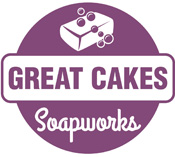Soaping with Anne-Marie

I was so excited to receive a signed copy of Anne-Marie Faiola’s new book Pure Soapmaking: How to Create Nourishing, Natural Skin Care Soaps along with a full kit to make the Annatto-Yarrow soap!
The book is so comprehensive, as it includes information about the soapmaking process, choosing equipment and molds, how to use herbs and other natural additives, choosing scents and designing recipes – PLUS 32 recipes ranging from simple to stunning. The Annatto-Yarrow soap is in the “Pure Beauty” category, but I think it also fits “Colorful & Creative”! This was a multiple-day, multiple-step project that included several firsts for me including these ingredients:
1. Yarrow powder
2. Pomace olive oil
3. Chia seed oil
4. Rosemary & bergamot essential oil blend
And these techniques:
1. Adding spirulina to lye water
2. Cutting embeds with a cheese slicer
3. Infusing annatto with a heat sealable tea bag and double boiler
4. Pouring soap in an “S” curve in the mold
Here’s a photo of the photo of Anne-Marie’s version:

The first step was to create the embeds with spirulina as the color. I’ve used spirulina in the past. It’s seaweed, and it smells like seaweed. This recipe calls for bergamot essential oil with this part of the soap, and I felt that it blended well with the spirulina scent. I’m sure the seaweed scent will fade over time.
The last time I used spirulina to color my soap, it stayed green for about 48 hours after I cut it, and then turned brown. This time the recipe called for a LOT more spirulina and it was added directly to the lye water instead of added at trace. (The yarrow powder was added to the lye water as well.)

I’m guessing the pomace olive oil worked well with this part of the soap since it has a somewhat greenish tint. I’ve heard that pomace can speed trace a bit, but I didn’t really notice if it did. The soap looked really dark green when I poured it in the mold:

Anne-Marie recommended a cheese slicer to create the “grass blade” embeds. I went to Walmart to see what I could find, and my choices were 1. a super cheap, flimsy one (I could tell the wire wasn’t taut enough to cut the soap), and 2. one that appeared more sturdy, except someone had broken the handle off in the package! And I mean ONE. It was the last one left! So I went to the register and asked the cashier if I could get a discount. He said he doesn’t really do that, but I assured him that I really needed it and was going to buy it anyway, so he ended up giving me a deal after all! Good thing you can still use a cheese slicer without a full handle, but it does take a bit of practice to maneuver it through a thin piece of soap, and I think I need more practice!

For the main part of the soap, I needed an annatto infusion. Anne-Marie spells out how to create a cold infusion and a hot infusion, and I didn’t have time for the cold one, so I created a double boiler with the annatto seeds inside a heat sealable tea bag with the olive oil. Except the recipe called for one ounce of olive oil and I couldn’t see creating such a small amount, so I used two.

Once the annatto infusion was done, I was ready to make the rest of the soap. This is where a small amount of chia seed oil was added. It has a very pleasant aroma! This is the part of the soap that was scented with equal parts rosemary and bergamot which I really love! Half the batch was colored with the annatto, and the other half had poppy seeds, and yes, the spirulina discolored the mold – oops! (photo #1). I poured each color alternately in an “S” curve in the mold (photo #2). I really like how this randomized the pattern in the cut soap, as you’ll see later. I should have stopped when I reached the fill level of photo #3, but I kept going… By the time I pushed the embeds in the soap, it was overflowing just a bit (see #4):

And here it is with dried calendula petals on top:

I finally unmolded and cut the soap this afternoon. The calendula petals were pulled through by my wire cutter, and I had to break off the “edges” that had overflowed, but overall, I think it turned out pretty great! I love how many different colors and textures are achieved by this technique. Unfortunately, the spirulina is already turning brown, but I can’t smell it at all, so that’s good. This was a FUN soap to make, and well worth the time and effort!

Page with Comments
Comments are closed.


That looks excellent! Thanks for sharing!
I am so glad you enjoyed the book and the Annatto-Yarrow soap kit! That recipe can require a bit of work but looks so gorgeous as a finished bar.